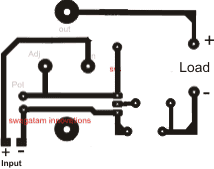
In this post I have explained how to construct a simple solar panel regulator controller circuit at home for charging small batteries such as 12V 7AH battery using small solar panel
Using a Solar Panel
We all know pretty well about solar panels and their functions. The basic functions of these amazing devices is to convert solar energy or sun light into electricity.
Basically a solar panel is made up with discrete sections of individual photo voltaic cells. Each of these cells are able to generate a tiny magnitude of electrical power, normally around 1.5 to 3 volts.
Many of these cells over the panel are wired in series so that the total effective voltage generated by the entire unit mounts up to an usable 12 volts or 24 volts outputs.
The current generated by the unit is directly proportional to the level of the sun light incident over the surface of the panel.
The power generated from a solar panel is normally used for charging a lead acid battery.
The lead acid battery when fully charged is used with an inverter for acquiring the required AC mains voltage for powering the house electrical. Ideally the sun rays should be incident over the surface of the panel for it to function optimally.
However since the sun is never still, the panel needs to track or follow the suns path constantly so that it generates electricity at an efficient rate.
If you are interested to build an automatic dual tracker solar panel system you may refer one of my earlier articles.
Without a solar tracker, the solar panel will be able to do the conversions only at around 30 % efficiency.
Coming back to our actual discussions about solar panels, this device may be considered the heart of the system as far converting solar energy into electricity is concerned, however the electricity generated requires a lot of dimensioning to be done before it can be used effectively in the preceding grid tie system.
Why do we Need a Solar Regulator
The voltage acquired from a solar panel is never stable and varies drastically according to the position of the sun and intensity of the sun rays and of course on the degree of incidence over the solar panel.
This voltage if fed to the battery for charging can cause harm and unnecessary heating of the battery and the associated electronics; therefore can be dangerous to the whole system.
In order to regulate the voltage from the solar panel normally a voltage regulator circuit is used in between the solar panel output and the battery input.
This circuit makes sure that the voltage from the solar panel never exceeds the safe value required by the battery for charging.
Normally to get optimum results from the solar panel, the minimum voltage output from the panel should be higher than the required battery charging voltage.
Meaning, even during adverse conditions when the sun rays are not sharp or optimum, the solar panel still should be able to generate a voltage more than say 12 volts which may be the battery voltage under charge.
Solar Voltage regulators available in the market can be too costly and not so reliable; however making one such regulator at home using ordinary electronic components can be not only fun but also very economical.
You may also want to read about this 100 Ah Voltage Regulator Circuit
Circuit Diagram
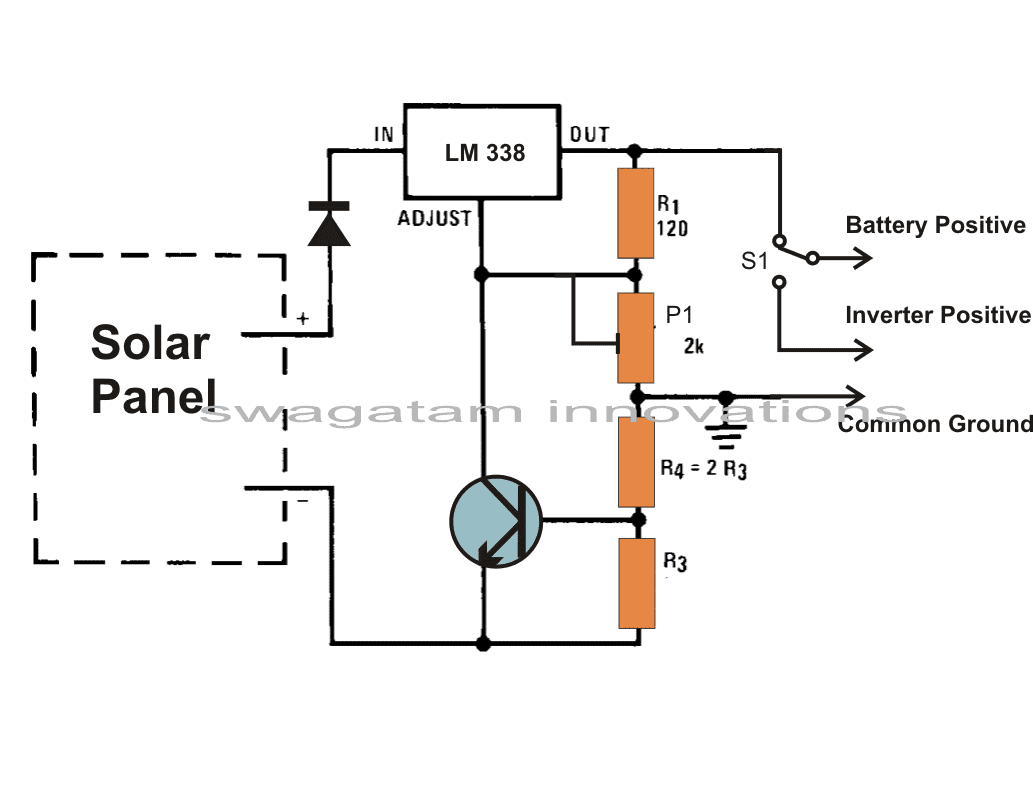
NOTE: PLEASE REMOVE R4, AS IT HAS NO REAL IMPORTANCE. YOU CAN REPLACE IT WITH A WIRE LINK.
Track side PCB Design (R4, Diode and S1 not included...R4 is actually not important and may be replaced with a jumper wire.
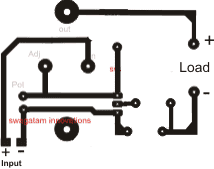
How it Works
Referring to the proposed solar panel voltage regulator circuit we see a design that utilizes very ordinary components and yet fulfills the needs just as required by our specs.
A single IC LM 338 becomes the heart of the entire configuration and becomes responsibly for implementing the desired voltage regulations single handedly.
The shown solar panel regulator circuit is framed as per the standard mode of the IC 338 configuration.
The input is given to the shown input points of the IC and the output for the battery received at the output of the IC.
The pot or the preset is used to accurately set the voltage level that may be considered as the safe value for the battery.
Current Controlled Charging
This solar regulator controller circuit also offers a current control feature, which makes sure that the battery always receives a fixed predetermined charging current rate and is never over driven. The module can be wired as directed in the diagram.
The relevant positions indicated can be simply wired even by a layman. Rest of the function is taken care of by the regulator circuit.
The switch S1 should be toggled to inverter mode once the battery gets fully charged (as indicated over the meter).
Calculating Charging Current for the Battery
The charging current may be selected by appropriately selecting the value of the resistors R3.
It can be done by solving the formula: 0.6/R3 = 1/10 battery AH The preset VR1 is adjusted for getting the required charging voltage from the regulator.
Solar Regulator with Adjustable Voltage and Current Output
The following figure shows a high current voltage regulator circuit using the LM338 ICs.
The high current is achieved by connecting many number of LM338 Ics in parallel over a single common heatsink.
The parallel LM338 are not shown in diagram but while building it practically you can connect at least 8 numbers of LM338 ICs in parallel.
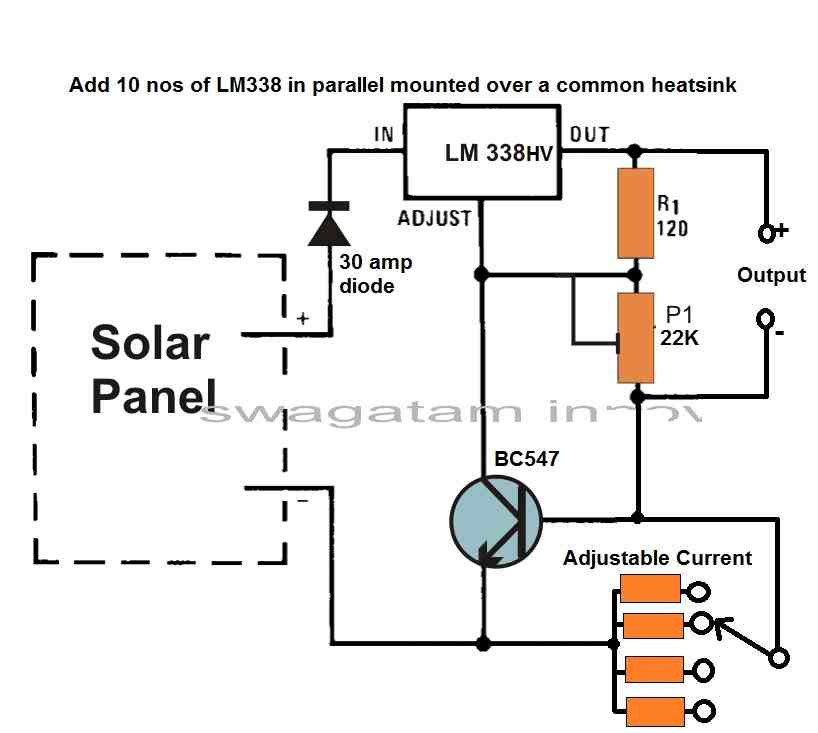
The input voltage can be as high as 50 V if LM338 HV IC is used.
The BC547 transistor is used for current control by adjusting the resistance at its base using a resistor ladder.
When many LM338 ICs are linked in parallel, the load current may be shared, enabling the circuit to tolerate larger currents.
As per the rules it is vital to remember that the output voltage of each IC may not be precisely the same, resulting in uneven load current sharing.
To avoid this, connect a tiny resistor (such as 0.1 ohms) in series with each IC's output to equalize current sharing.
However, as we have already mentioned that the ICs must be connected over a single common heatsink so that the heat dissipation can be shared and the ICs conduct equally. Therefore, adding a 0.1 ohm resistor may not be critical.
The BC547 transistor connected to the ADJ pin of the LM338 acts as a current sink for the IC, allowing the current to be adjusted by changing the resistance at the base of the transistor.
The resistor ladder connected to the base of the transistor allows for easy selection of the desired current level.
Overall, this circuit provides a high current, adjustable voltage regulation solution using the LM338 ICs in parallel.
However, it's important to ensure that the heatsink can handle the heat dissipation of multiple ICs operating at high currents to prevent thermal issues.
Solar Regulator using IC LM324
For all solar panel systems, this single IC LM324 based guaranteed efficient regulator circuit offers an energy-saving answer to charging batteries of the lead-acid type typically seen in motor vehicles.
Not taking into consideration the price of the solar cells, believed to be in front of you for use in various other plans, the solar regulator on their own is below $10.
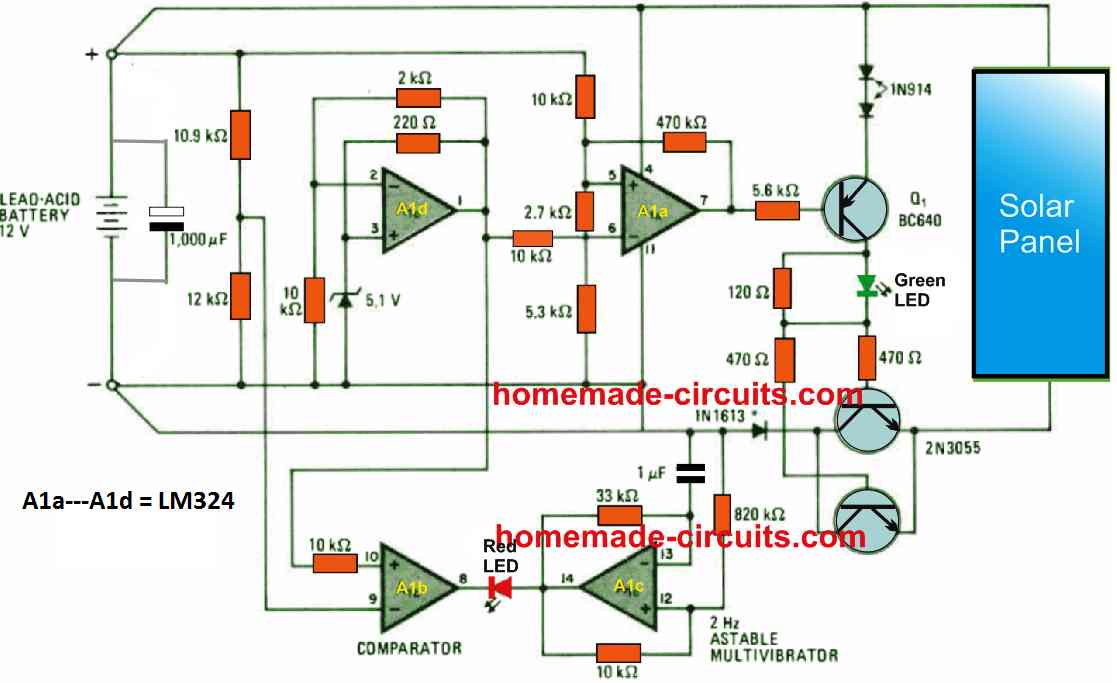
As opposed to a number of other shunt regulators that will redirect current through a resistor once the battery is completely charged, this circuit disconnects the charging supply from the battery eliminating the need of bulky shunt resistors.
How the Circuit Works
As soon as the battery voltage, is under 13.5 volts (usually the open-circuit voltage of a 12 V battery), transistors Q1, Q2, and Q3 switch on and charging current passes through the solar panels as intended.
The active green LED shows the battery is getting charged. As the battery terminal voltage nears the open-circuit voltage of the solar panel, op amp A1a switches OFF transistors Q1-Q3.
This situation is latched for so long as the battery voltage drops to 13.2 V, whereafter the triggering of the battery charging process is again restored.
In the absence of a solar panel, when the battery voltage keeps dropping from 13.2V to roughly 11.4 V, implying a totally discharged battery, A1b, output switches to 0V, triggering the attached RED LED to blink at a rate fixed by the astable multivibrator A1c.
In this situation blinking at a rate of 2 hertz. Op amp A1d gives a reference of 6 V to retain the switching thresholds at the 11.4 V and the 13.2 V levels.
The proposed LM324 regulator circuit is designed to cope with currents up to 3 amperes.
To work with more substantial currents, it may be essential to make the Q2, Q3 base currents higher, to ensure that all these transistors can maintain saturation throughout the charging sessions.
Solar Panel Regulator Circuit using IC 741
The majority of typical solar panels provide around 19V off load.
This enables to get a drop of 0.6V over a rectifier diode while charging a 12V lead-acid battery. The diode prohibits battery current from moving via the solar panel during night.
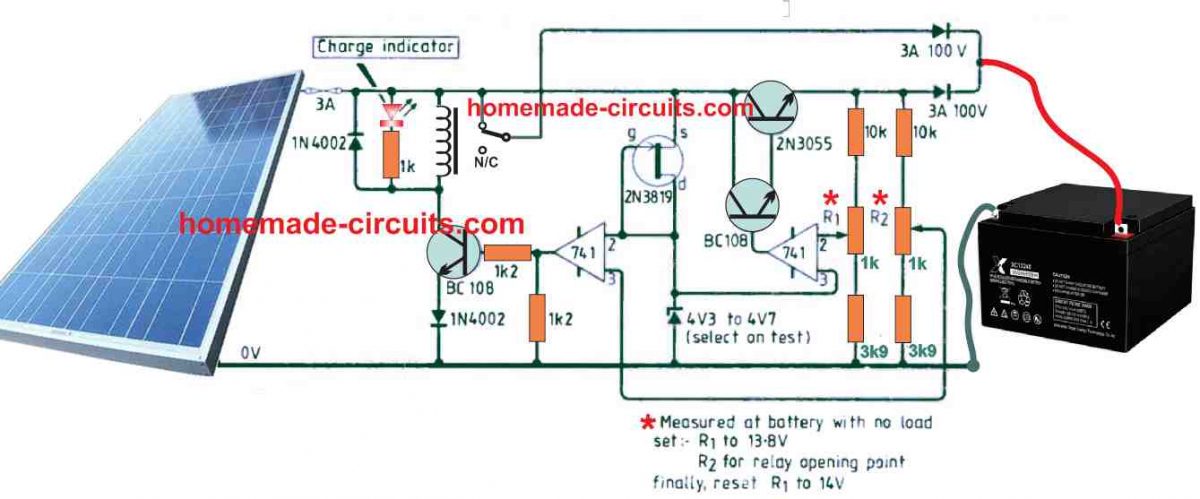
This set up can be great so long as the battery does not get overcharged, since a 12V battery can easily become overcharged to above 1V5, in case the charging supply is not controlled.
Voltage drop induced through a series pass BJT, typically is approximately 1.2V, which appears to be way too high for nearly all solar panels to operate effectively.
Both the above flaws are effectively removed in this simple solar regulator circuit. Here, energy from the solar panel is supplied to the battery via a relay and rectifier diode.
How the Circuit Works
When battery voltage extends to 13.8V, the relay contacts click, so that 2N3055 transistor begins trickle charging the battery to a optimum of 14.2V.
This full charge voltage level could be fixed a bit lower, despite the fact that most lead-acid batteries start gassing at 13.6V. This gassing is significantly increased at overcharge voltage.
The relay contacts operate the moment battery voltage drops under 13.8V. Battery power is not utilized to operate the circuit.
The fet serves like a constant current source.
Shunt Type Solar Voltage Regulator Circuit
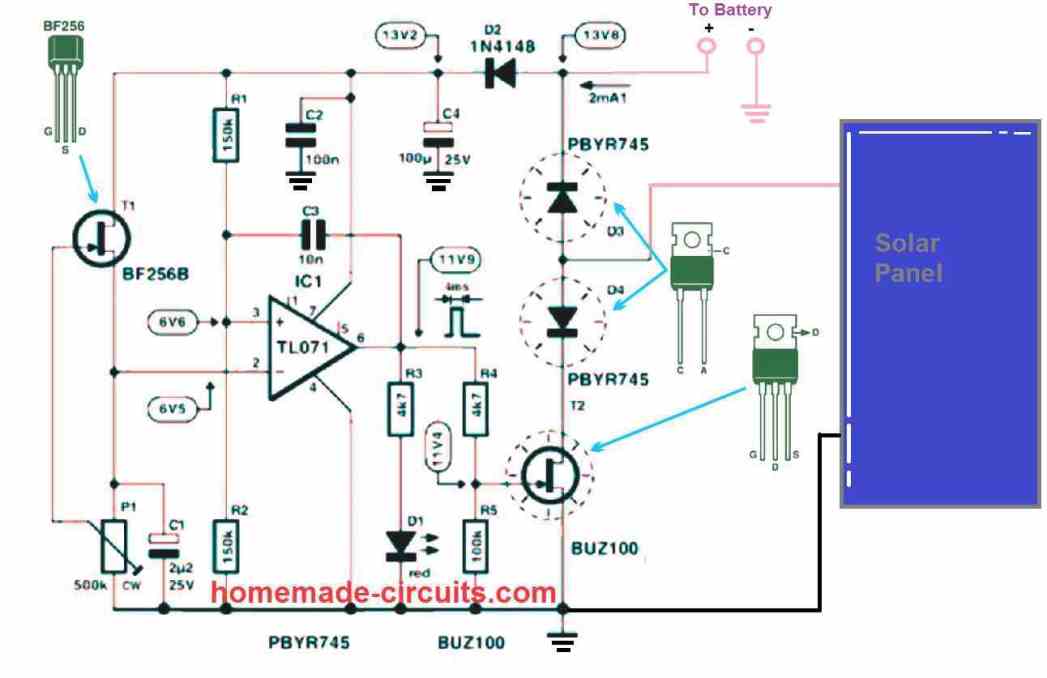
The shunt type solar panel regulator circuit shown above can be understood with the following points:
The op amp TL071 is configured like a comparator.
The FET BF256 along with the 500k preset P1 forms a constant current and constant voltage reference generator for the inverting input of the op amp.
THe pin3 which is the non-inverting input for the op amp is held with varying voltage source depending on the level of the battery terminal voltage, therefore this pin3 works like the over charge sensing input of the compartaor op amp.
The preset P1 at pin2 of the IC is adjusted in such a way that the potential at pin3 input of the IC is just higher the pin2 as soon as the battery reaches the full charge level.
While the battery level is below the full charge value, the potential at the pin3 is lower than the pin2 which keeps the output of the op amp to zero logic, and the FET T2 BUZ100 remains switched OFF.
However, as soon as the battery reaches the full charge level, the pin3 potential now increase above the pin2 value, which causes the output of the op amp to change state to a high output.
This immediately switches ON the FET T1, which shunts the solar panel voltage to ground, thereby preventing any further charging of the battery.
While the solar panel voltage is being shunted by the FET T1 via the diode D4, these two devices can get substantially hot, since the whole solar panel power gets grounded by these two devices.
The diode D3 ensures that once the battery is charged, it never gets discharged through the solar panel, especially during the night time.
The LED D1 indicates when the battery is fully charged and cut off, as it gets switched ON.
Parts List
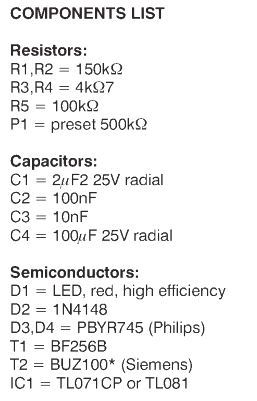


With over 50,000 comments answered so far, this is the only electronics website dedicated to solving all your circuit-related problems. If you’re stuck on a circuit, please leave your question in the comment box, and I will try to solve it ASAP!